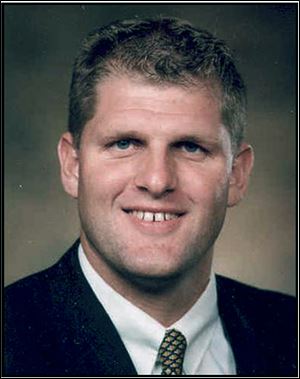
House district redo fuels Ohio Democrats' drama
12/16/2011

State Rep. Matthew Szollosi (D., Oregon)
COLUMBUS — Negotiations that led to the restoration of portions of the city of Toledo and eastern Lucas County to the 9th Congressional District pitted Democrat against Democrat.
“It was intense,” said Rep. Matt Szollosi (D., Oregon), the No. 2 Democrat in the Ohio House. “I don’t like to be put in that position. I don’t like it when Democrats are put against Democrats. It’s unfortunate that that occurred. Ultimately, there are certainly Democrats who don’t like the result, but this was the best that we could achieve under very difficult circumstances.”
The shifting of roughly 102,000 people from the 4th District, held by Rep. Jim Jordan (R., Urbana) back into the 9th District also forced a major eastward shift for the largely rural 4th to compensate for the population loss. That means the same congressman representing the citizens of Urbana in Champaign County will also represent citizens of Lorain County some 150 miles away.
“It’s the prototypical gerrymandered district, clearly the result of a flawed process,” Mr. Szollosi said.
In the end, every northwest Ohio lawmaker, Democrat and Republican, in the House and Senate supported the final compromise map passed Wednesday night. Most of the “no” votes came from northeast Ohio Democrats.
Compared to the prior map enacted primarily with Republican votes in September, the new map made changes to some specific districts in the Toledo, Columbus, and Dayton areas. But in the end, it is still believed to have produced 12 relatively safe Republican districts and four solid Democratic districts.
The bill, which Gov. John Kasich signed into law Thursday, will restore the single March 6 primary election, ending plans to hold a separate presidential and congressional primary in June because of the uncertainty over district lines. Candidates for the latter offices now have until Dec. 30 to file their petitions to run in the March 6 primary.
It also creates a new bipartisan task force to try to develop alternatives to the once-in-a-decade process of redrawing congressional and state legislative districts after each U.S. Census.
The new and presumably final map still sets up a potential primary election showdown between two veteran Democrats — U.S. Reps. Marcy Kaptur, of Toledo, and Dennis Kucinich, of Cleveland — in the revised 9th District that runs along the Lake Erie shore between the two cities.
The new map, however, moved many of Miss Kaptur’s prior constituents back into the 9th and is generally considered to be friendlier to Miss Kaptur’s re-election.
“The good news is we know the shape of the new 9th District,” said Kaptur spokesman Steve Fought. “The bad news is we have only 12 weeks for people in the new part to meet Marcy.”
Mr. Kucinich could not be reached for comment Thursday.
Some Cleveland-area Democrats have voiced fear that Mr. Kucinich will instead run in the neighboring 11th District stretching from Cleveland to Akron and potentially endanger U.S. Rep. Marcia Fudge, the only African-American in Ohio’s congressional delegation.
Among those opposing this map and its predecessor was state Sen. Nina Turner (D., Cleveland), an African-American who is also running in the 11th District.
“It’s laughable, no matter how many Democrats in the House decide to toe the party line to vote for a map that’s still 12-4…” she said. “As I’ve said before, this process has been far too much about seats and not enough about service. And recent information has revealed that the map was not created in the hearings held across this great state or even in a committee room in Columbus. We now know that it was crafted in a hotel room down the street.”
A handful of Democrats Wednesday held a news conference in that hotel room in downtown Columbus that Republicans rented for three months to serve as the “bunker” for their redistricting operations.
State Rep. Dennis Murray (D., Sandusky) has asked the Ohio inspector general and legislative inspector general to investigate whether behind-closed-door meetings and conversations with Washington leaders violated state opening meeting and public records laws.
The revised 9th District contains all but Wards 21, 22, and 23 and part of the 3rd in northwest Toledo and portions of the 7th, 16th, and 24th in the southwest. The district again includes all of the eastern Lucas County suburbs and tightly hugs the Lake Erie shoreline to incorporate parts of Ottawa, Erie, Lorain, and Cuyahoga counties.
Mr. Szollosi said the unanimous bipartisan support of northwest Ohio lawmakers for the final map is indicative of the support for the changes made to the 9th District.
“It underscores the importance of Marcy Kaptur in the U.S. Congress,” he said. “The economic impact of the representation for northwest Ohio can’t be overstated. She’s the senior-most woman in the U.S. House, and she has a seat on the powerful Appropriations Committee. Whether you’re a Democrat or a Republican, it’s hard to argue with the impact of having a representative at that level of the federal government with respect to resources for our area.”
Mr. Jordan’s new S-shaped 4th District would stretch west to Mercer County near the Indiana line, north to the Sandusky Bay, as far west as Lorain County, and as far south as Champaign County.
It encompasses all of Sandusky, Seneca, Crawford, Union, Logan, Champaign, Shelby, Auglaize, and Allen counties; southern Erie; northern Huron; north-central Lorain; northwest Marion, and a bit of southwest Mercer.
The Campaign for Accountable Redistricting, a coalition of groups such as the League of Women Voters and Ohio Citizen Action, scored the district at just 25.7 out of a scale of 100 for compactness. That’s still far higher than the 7.3 score it gave the final 9th District.
In addition to the seven Toledo wards that it retained, the 5th District, held by Rep. Bob Latta (R., Bowling Green), encompasses much of the rural northwest corner of the state. It also contains all of Wood, Fulton, Williams, Henry, Defiance, Hancock, Putnam, Paulding, Van Wert, Hardin, and Wyandot counties, most of western Ottawa, and most of Mercer.
At 52.2, the district garnered the second-highest score that Accountable Redistricting gave any district in the state for compactness.
Mr. Latta said he hasn’t seen enough details to know whether his new district is any more Democratic-leaning than its predecessor. But he said some of the areas, such as in Ottawa and Lucas counties, were ones he represented when he was a state senator from 1997 to 2001.
“I’m not going into unfamiliar country,” he said. “I’m going into area that I know very well. I’m looking forward to representing all the new area in Congress.”
Angela Zimmann of Springfield Township, a Democrat challenging Mr. Latta in 2012, said the new district has more Democratic-leaning voters than the existing district boundaries and thus improves her chances of winning the election.
“The new District 5 is more competitive than the old District 5 because we have Maumee, we have Sylvania, we have [seven] wards in Toledo,” she said. “Those things make District 5 more competitive.”
Contact Jim Provance at:
jprovance@theblade.com
or 614-221-0496.